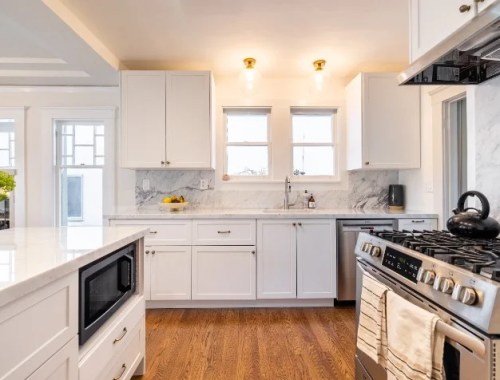
Home Improvement: Enhancing Your Living Space
Introduction
Embarking on a journey of home improvement can significantly transform your living space, making it more comfortable, aesthetically pleasing, and energy-efficient. Whether you’re looking to revamp your interiors, upgrade your exteriors, or implement sustainable solutions, this guide will provide valuable insights to kickstart your project with confidence.
The Importance of Home Improvement
Home improvement endeavors serve multiple purposes beyond just enhancing aesthetics. They play a crucial role in:
Enhancing Comfort and Livability
Transforming your home allows you to tailor the space to your lifestyle, creating a more comfortable and enjoyable environment for you and your family.
Increasing Property Value
Well-executed home improvements can substantially increase the market value of your property, offering significant returns on investment.
Boosting Energy Efficiency
Implementing energy-efficient upgrades not only reduces utility bills but also minimizes your environmental footprint, contributing to a sustainable future.
Types of Home Improvement Projects
Home improvement projects encompass a wide range of renovations and upgrades, including:
Interior Renovations
From kitchen remodels to bathroom upgrades, interior renovations focus on enhancing functionality and aesthetics within your home.
Exterior Upgrades
Exterior renovations such as landscaping, roofing, and siding replacements improve curb appeal and overall property value.
Energy-Efficient Enhancements
Installing energy-efficient windows, insulation, and HVAC systems can significantly reduce energy consumption and enhance comfort.
Planning Your Home Improvement Journey
Effective planning is crucial for the success of any home improvement project. Consider the following steps:
Setting Goals and Budget
Clearly define your renovation goals and establish a realistic budget to guide your project.
Researching Contractors and Materials
Thoroughly research contractors and materials to ensure quality workmanship and durable results.
Obtaining Necessary Permits and Permissions
Ensure compliance with local regulations by obtaining the required permits and permissions before commencing work.
DIY vs. Hiring Professionals
Deciding between DIY projects and hiring professionals involves weighing the pros and cons:
Pros and Cons of DIY
DIY projects offer cost savings and a sense of accomplishment but may require significant time and effort, with potential risks of errors.
Benefits of Hiring Professionals
Professional contractors bring expertise, efficiency, and quality craftsmanship to your project, ensuring superior results with minimal stress.
Financing Your Home Improvement
Explore various financing options to fund your home improvement endeavors:
Budgeting and Saving
Start budgeting and saving early to cover project costs without relying heavily on loans or financing.
Loans and Financing Options
Consider personal loans, home equity loans, or lines of credit to finance larger-scale renovations, balancing monthly payments with your budget.
Government Grants and Incentives
Research available grants and incentives for energy-efficient upgrades or eco-friendly renovations, potentially offsetting project expenses.
Sustainability in Home Improvement
Embracing sustainability in home improvement can reduce environmental impact and enhance long-term efficiency:
Eco-Friendly Materials
Choose eco-friendly building materials and finishes to minimize environmental footprint and promote indoor air quality.
Energy-Efficient Appliances
Invest in energy-efficient appliances and fixtures to reduce energy consumption and lower utility bills over time.
Water Conservation Strategies
Implement water-saving measures such as low-flow faucets, rainwater harvesting systems, and drought-resistant landscaping.
Trends in Home Improvement
Stay informed about the latest trends shaping the home improvement landscape:
Smart Home Technology
Integrate smart home devices and automation systems to enhance convenience, security, and energy management.
Multi-Functional Spaces
Maximize functionality and versatility with multi-purpose rooms that adapt to varying needs and lifestyles.
Aging-in-Place Design
Incorporate universal design principles to create accessible and adaptable living spaces suitable for all ages and abilities.
Maintaining Your Home Improvement
Preserving the results of your home improvement projects requires ongoing maintenance and care:
Regular Inspections and Maintenance
Schedule routine inspections and maintenance tasks to identify issues early and prevent costly repairs.
Addressing Wear and Tear
Promptly address wear and tear by repairing or replacing damaged components to maintain the integrity and appearance of your home.
Updating for Long-Term Satisfaction
Continuously update and upgrade your home to align with evolving needs, preferences, and lifestyle changes for lasting satisfaction.
Conclusion
Embarking on a home improvement journey is an exciting opportunity to enhance your living space, increase property value, and embrace sustainability. By following the comprehensive guidelines outlined in this article, you can confidently navigate the planning, execution, and maintenance phases of your projects, ensuring optimal results and long-term satisfaction.
FAQs
- How do I choose the right contractor for my home improvement project?
- What are some cost-effective ways to improve energy efficiency at home?
- Are there any government incentives available for eco-friendly renovations?
- Can I undertake major renovations without professional assistance?
- How can I ensure my home improvement project stays within budget?
- What are the key factors to consider when planning a kitchen remodel?
You May Also Like

The Ultimate Guide to Outdoor Dining Sets
April 1, 2024
The Ins and Outs of Commercial Property Investment
May 1, 2024

